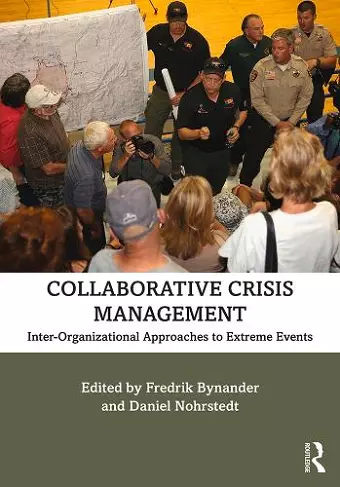Collaborative Crisis Management
Inter-Organizational Approaches to Extreme Events
Fredrik Bynander editor Daniel Nohrstedt editor
Format:Paperback
Publisher:Taylor & Francis Ltd
Published:9th Dec '19
Currently unavailable, and unfortunately no date known when it will be back
This paperback is available in another edition too:
- Hardback£145.00(9780367148522)

Public organizations are increasingly expected to cope with crisis under the same resource constraints and mandates that make up their normal routines, reinforced only through collaboration. Collaborative Crisis Management introduces readers to how collaboration shapes societies’ capacity to plan for, respond to, and recover from extreme and unscheduled events.
Placing emphasis on five conceptual dimensions, this book teaches students how this panacea works out on the ground and in the boardrooms, and how insights on collaborative practices can shed light on the outcomes of complex inter-organizational challenges across cases derived from different problem areas, administrative cultures, and national systems. Written in a concise, accessible style by experienced teachers and scholars, it places modes of collaboration under an analytical microscope by assessing not only the collaborative tools available to actors but also how they are used, to what effect, and with which adaptive capacity. Ten empirical chapters span different international cases and contexts discussing:
- Natural and "man-made" hazards: earthquakes, hurricanes, wildfires, terrorism, migration flows, and violent protests
- Different examples of collaborative institutions, such as regional economic communities in Africa, and multi-level arrangements in Canada, the Netherlands, Turkey, and Switzerland
- Application of a multimethod approach, including single case studies, comparative case studies, process-tracing, and "large-n" designs.
Collaborative Crisis Management is essential reading for those involved in researching and teaching crisis management.
"Crisis collaboration across geographical and administrative borders is a must. It is also extremely hard. Under the guidance of Bynander and Nohrstedt, crisis experts pursue the Holy Grail of crisis collaboration in an exciting set of case studies. Extremely relevant for both academics and practitioners. A welcome addition to the crisis literature!" —Arjen Boin, Leiden University
"Collaborative Crisis Management addresses collective action dilemma in response to major crises and disasters such as terrorism, wildfires, and earthquakes in different geographies, cultures, and political and administrative settings. This timely volume provides conceptually and analytically valuable perspectives from experts in the field in applying network governance in dealing with crises and disasters. The volume is an essential resource for both scholars and practitioners." —Naim Kapucu, Ph.D., Pegasus Professor & Director of the School of Public Administration, University of Central Florida
“Emergency management is, above all, a social process. This authoritative book provides a valuable structure for analyzing the participation of people and organizations in crisis response. Its coverage of hazards and geographical areas is broad and eclectic. In responding to disasters and major incidents, collaboration is becoming more and more necessary. Many different agencies are likely to be involved, and hence the interorganizational perspective brought by the authors of this book is particularly welcome.” —David Alexander, Professor of Risk and Disaster Reduction, University College London
ISBN: 9780367148560
Dimensions: unknown
Weight: 360g
166 pages